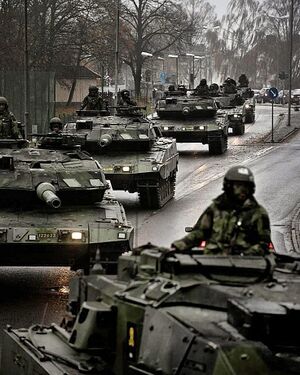Acrean Intervention in the Zemplen War: Difference between revisions
No edit summary |
No edit summary |
||
| Line 6: | Line 6: | ||
| image_size = | | image_size = | ||
| alt = | | alt = | ||
| caption = A column of Acrean | | caption = A column of Acrean armoured vehicles in Mátészalka, November 2009 | ||
| date = September 2008-July 2010 | | date = September 2008-July 2010 | ||
| place = [[Ruvelka]] | | place = [[Ruvelka]] | ||
Revision as of 10:30, 6 January 2023
| Operation Stuðningur | |||||
|---|---|---|---|---|---|
| Part of the Zemplen War | |||||
 A column of Acrean armoured vehicles in Mátészalka, November 2009 | |||||
| |||||
| Belligerents | |||||
|
|
| ||||
| Units involved | |||||
|
Acrean Armed Forces Imperial Armed Forces of Ruvelka | Syaran Commonality Armed Forces | ||||
| Strength | |||||
| Various | Various | ||||
Acrean Intervention in the Zemplen War, code named Operation Stuðningur, was initiated by Acrean Chancellor Hans-Christian Sørensen on 3 August 2008 at the request of Ruvelkan Chancellor Edviná Molnár in response to the Syaran invasion of Ruvelka during the Zemplen War. The operation consisted of two main components; the deployment of Acrean expeditionary combat forces to Ruvelka and the establishment of sustainable logistics support to Ruvelka. All forces deployed were organised under Acrean Forces in Ruvelka (ACRFR), a theatre command led by Supreme Commander General Jürgen von Edel, supported by RAMC General Ludwig Skarsgård and Army Generals Eirik Stordalen and Frederik Rasmussen. An air combat command controlling elements of the Royal Acrean Air Force who were deployed to the theatre to support Ruvelkan capabilities in the air was placed under the command of RAAF General Michel Volland. ACRFR's wartime order of battle consisted of 16 Army divisions and 4 RAMC divisions for 20 total combat divisions for ground forces, which were supported by a minimum of 600 fixed-wing combat aircraft from the RAAF. RAAF strength in Ruvelka varied during the conflict, reaching a peak of 764 aircraft deployed by September 2009.